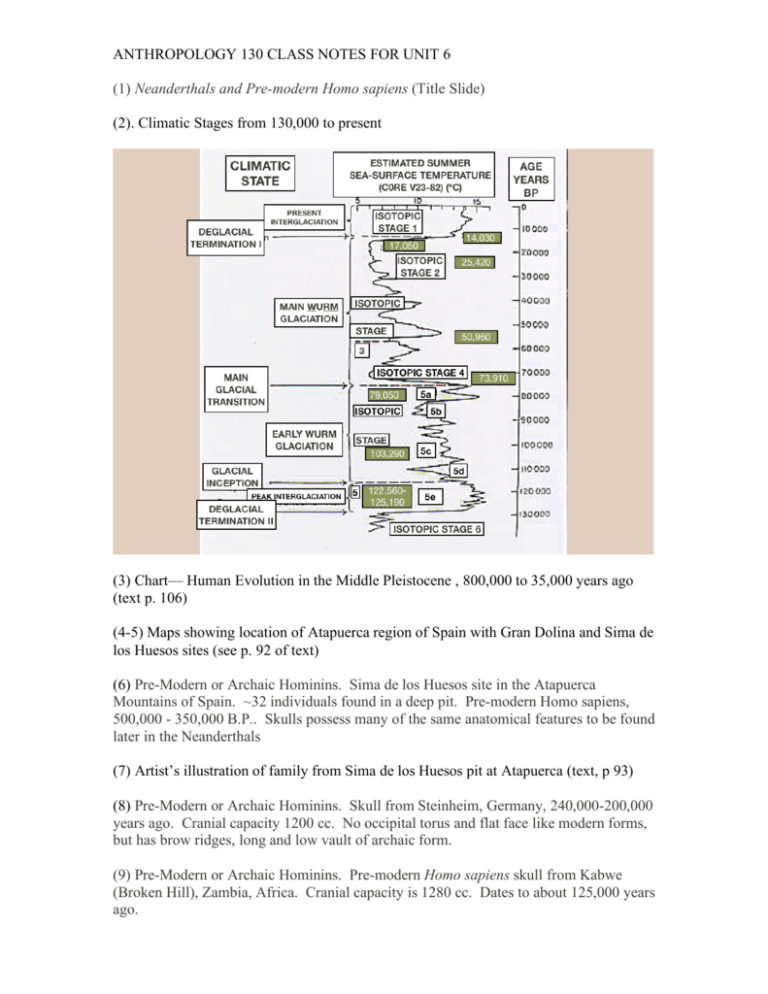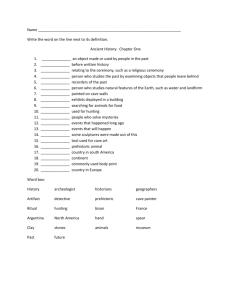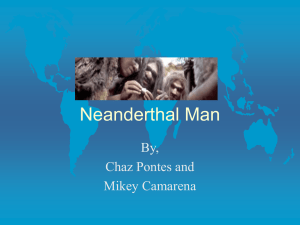(2). Climatic Stages from 130
advertisement

ANTHROPOLOGY 130 CLASS NOTES FOR UNIT 6 (1) Neanderthals and Pre-modern Homo sapiens (Title Slide) (2). Climatic Stages from 130,000 to present (3) Chart— Human Evolution in the Middle Pleistocene , 800,000 to 35,000 years ago (text p. 106) (4-5) Maps showing location of Atapuerca region of Spain with Gran Dolina and Sima de los Huesos sites (see p. 92 of text) (6) Pre-Modern or Archaic Hominins. Sima de los Huesos site in the Atapuerca Mountains of Spain. ~32 individuals found in a deep pit. Pre-modern Homo sapiens, 500,000 - 350,000 B.P.. Skulls possess many of the same anatomical features to be found later in the Neanderthals (7) Artist’s illustration of family from Sima de los Huesos pit at Atapuerca (text, p 93) (8) Pre-Modern or Archaic Hominins. Skull from Steinheim, Germany, 240,000-200,000 years ago. Cranial capacity 1200 cc. No occipital torus and flat face like modern forms, but has brow ridges, long and low vault of archaic form. (9) Pre-Modern or Archaic Hominins. Pre-modern Homo sapiens skull from Kabwe (Broken Hill), Zambia, Africa. Cranial capacity is 1280 cc. Dates to about 125,000 years ago. (10) Map of sites in Africa, Europe and Australia (text, p. 108) (11) Homo neanderthalensis. The first Neanderthal was found in 1856 in a limestone cave in the Valley of the Neander River, near Düsseldorf, Germany (12) Map showing the location of La Chapelle aux Saints in France. (13) Neanderthal skeleton from the site of La Chapelle Aux Saints, France.Cranial capacity - 1650 cc. Illustration is of an old individual with a deformed leg and arm bones due to arthritis. It was used as the type specimen creating an erroneous impression of the neanderthal posture (illustration on p. 117 of text). (14) Comparison of skull of Neanderthal and modern Homo sapiens (15) The Neanderthal Face. Note medial nasal projections (16) Map of Neanderthal sites (17) Neanderthal Skulls from Amud Cave (left) and from Tabun Cave (right), Israel (18) Photographic view of opening to Shanidar Cave. (19) Drawing of Shanidar Cave interior showing pens for sheep and goats and excavation trench location. (20) Photo of interior of Shanidar Cave (21) Photo of deep pit excavation in Shanidar Cave (22) Cross section of upper part of the excavation in Shanidar Cave (23) Cross section of lower part of excavation in Shanidar Cave (24-26) Photographs of skull and long bones of Shanidar I (27) Burial of Shanidar IV. (28) Neanderthal from Burial IV, Shanidar Cave, Iraq. Adult male. Associated with fauna and pollen of medicinal plants Dates to about 60,000 BP. (29) Neanderthal Burial, La Ferassie Cave, France. 8 skeletons recovered from the cave. Dates to >38,000 BP (30) Late Neanderthal individual from the Chatelperronian level of cave at St. Cesaire, France Dates from approximately 40,000 - 35,000 BP (31) Levallois procedure for making stone points and blades. (32) Levallois or Mousterian Technology Drawing of Levallois core and detached flake. Levallois core and detached point. (33) Levallois points for use as spear points (34) Tools from the Neanderthal occupation, Tabun Cave. Mousterian Level Artifacts (35) Drawing of tools of Mousterian of Acheulean and Levallois facies, France (36) Neanderthal Art, pendants for a necklace, from Arcy-sur-Cure site, France, c. 35,000 BP (37) View of Homo sapiens (Cromagnon) and Neanderthal (Shanidar) skulls.








